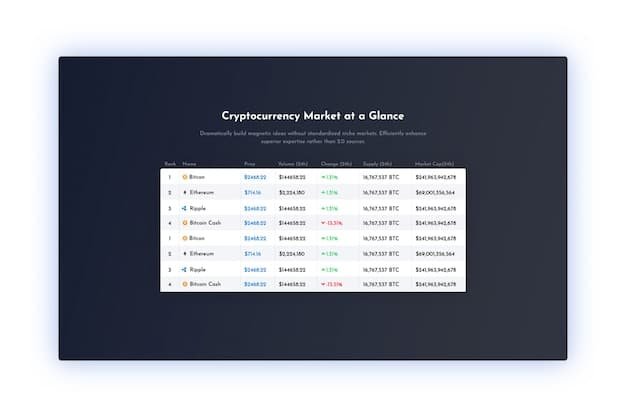Crypto Staking in 2025: Earn Up to 12% APY

Crypto staking in 2025 offers a compelling opportunity for investors to earn passive income, potentially reaching up to 12% APY, by locking up their digital assets and participating in the validation process of blockchain networks, enhancing network security and efficiency.
Looking ahead to 2025, the landscape of crypto staking is evolving, presenting potentially lucrative opportunities for investors. Imagine earning up to 12% APY on your digital assets simply by participating in the network’s security. This is the promise of crypto staking in 2025: How to Earn Up to 12% APY on Your Idle Coins.
Understanding Crypto Staking
Crypto staking has emerged as a popular method for cryptocurrency holders to earn rewards. It involves participating in the consensus mechanism of a blockchain network by locking up a certain amount of your cryptocurrency. This process helps to validate transactions and secure the network.
What is Proof of Stake (PoS)?
Proof of Stake (PoS) is a consensus algorithm that selects validators based on the amount of cryptocurrency they hold and are willing to “stake.” Unlike Proof of Work (PoW), which requires significant computational power, PoS is more energy-efficient and scalable.
How Staking Works
Staking involves locking up a portion of your crypto holdings in a staking wallet. By doing so, you become a validator, responsible for verifying transactions and maintaining the integrity of the blockchain. In return, you receive staking rewards, which can be a percentage of the transaction fees or newly minted coins.
- 💰 The amount required to stake varies by cryptocurrency.
- 🔒 Staking periods can be flexible or fixed, affecting the potential rewards.
- 🔄 Rewards are typically distributed periodically, such as daily or weekly.
In essence, crypto staking offers a way to earn passive income by contributing to the security and functionality of a blockchain network. As the crypto space matures, understanding the nuances of staking becomes crucial for investors looking to maximize their returns.
The Evolution of Staking by 2025
As we approach 2025, the crypto staking landscape is projected to undergo significant advancements. Technological innovations, regulatory clarity, and increasing adoption are expected to shape the future of staking, offering enhanced opportunities and potentially higher rewards for participants.

Technological Advancements
Advancements in blockchain technology are expected to streamline the staking process, making it more accessible and efficient. Innovations include improved smart contract functionality, decentralized finance (DeFi) integrations, and enhanced security measures.
Regulatory Landscape
The regulatory environment surrounding crypto staking is gradually becoming clearer. As governments worldwide develop frameworks for digital assets, staking platforms will need to comply with new regulations, providing greater transparency and investor protection.
These factors are poised to elevate the accessibility and profitability of crypto staking. Staying informed about these trends will be vital for investors aiming to capitalize on the opportunities presented by the evolving crypto landscape.
Maximizing APY: Strategies for 2025
To achieve the target of earning up to 12% APY through crypto staking in 2025, employing strategic approaches is essential. This involves carefully selecting the right cryptocurrencies, platforms, and staking methods.
Choosing the Right Cryptocurrencies
Selecting high-potential cryptocurrencies with attractive staking rewards is crucial. Look for projects with strong fundamentals, active communities, and sustainable staking models. Researching the team behind the project and understanding its long-term vision can also help identify promising opportunities.
- 🔎 Research cryptocurrencies with high staking APYs and strong market potential.
- 🛡️ Evaluate the security and reliability of staking platforms.
- 🔄 Consider the liquidity and trading volume of the staked cryptocurrencies.
Diversifying Staking Portfolio
Diversification is a key strategy to mitigate risk and maximize potential returns. By spreading your investments across multiple cryptocurrencies and staking platforms, you can reduce the impact of any single asset’s performance on your overall portfolio.
Effectively maximizing APY in crypto staking requires a deep understanding of market dynamics, a willingness to adapt to changing conditions, and a commitment to staying informed about the latest developments in the crypto space.
Risks and Mitigation Strategies
While crypto staking offers attractive earning opportunities, it also comes with inherent risks that investors need to be aware of. Understanding these risks and implementing effective mitigation strategies is paramount to protecting your investments.
Understanding Volatility
The cryptocurrency market is known for its volatility, which can significantly impact the value of staked assets. Sudden price drops can erode your potential profits and even lead to losses. To mitigate this risk, consider staking stablecoins or diversifying your portfolio with less volatile assets.
Security Risks
Staking platforms are vulnerable to hacking and security breaches, which could result in the loss of your staked assets. To minimize this risk, choose platforms with robust security measures, such as multi-factor authentication and cold storage of funds.
Successfully navigating the risks associated with crypto staking requires a proactive approach, a commitment to due diligence, and a willingness to adapt to changing market conditions.
Top Platforms for Crypto Staking in 2025
Selecting the right platform for crypto staking is crucial for maximizing returns and ensuring the security of your assets. Several platforms are expected to offer competitive staking opportunities in 2025, each with its own advantages and disadvantages.

Centralized Exchanges
Centralized exchanges like Binance, Coinbase, and Kraken offer user-friendly interfaces and a wide range of supported cryptocurrencies. They often provide staking services directly on their platforms, making it easy for users to participate.
Decentralized Platforms
Decentralized platforms, such as Lido and Rocket Pool, offer more control and transparency compared to centralized exchanges. These platforms allow users to stake their cryptocurrencies directly on the blockchain, often with higher APYs.
Choosing the right staking platform requires careful consideration of your individual needs and risk tolerance. By conducting thorough research and staying informed about the latest developments in the crypto space, you can make informed decisions and optimize your staking strategy.
Future Trends in Crypto Staking
The future of crypto staking is dynamic and influenced by advancements in technology, regulatory developments, and evolving market trends. Staying informed about these trends is essential for investors looking to remain competitive and capitalize on emerging opportunities.
Institutional Adoption
As the crypto market matures, institutional investors are increasingly entering the staking space. This influx of capital and expertise is expected to drive innovation and improve the overall efficiency of staking platforms. Institutions may also bring greater regulatory scrutiny, leading to more standardized and secure staking practices.
- 🏦 Increased institutional investment in staking platforms.
- ✅ Development of more sophisticated risk management tools and strategies.
- 🌐 Greater regulatory clarity and standardized staking practices.
DeFi Integrations
The integration of staking with decentralized finance (DeFi) protocols is expected to grow, offering users more flexibility and earning potential. DeFi platforms may offer innovative staking products, such as yield farming and liquidity mining, which combine staking with other DeFi activities.
By staying informed and adapting to these changes, investors can position themselves to take advantage of the evolving opportunities in the crypto staking landscape.
| Key Point | Brief Description |
|---|---|
| 💰 Staking Potential | Earn up to 12% APY by staking your idle crypto coins. |
| 🔒 Staking Definition | Participate in network validation and earn rewards. |
| 🛡️ Risk Mitigation | Diversify portfolio to reduce risk and maximize earnings. |
| 🔄 Future Trends | Institutional adoption and DeFi integrations will shape staking. |
Frequently Asked Questions (FAQ)
▼
Crypto staking involves holding and “locking” your cryptocurrency in a wallet to support the operations of a blockchain network. You earn rewards for participating in the network’s validation process.
▼
The APY (Annual Percentage Yield) varies depending on the cryptocurrency and platform. In 2025, it’s possible to earn up to 12% APY on select coins and platforms.
▼
Risks include price volatility, security breaches on staking platforms, and lock-up periods where you cannot access your funds. Diversification can help mitigate these risks.
▼
Top platforms include Binance, Coinbase, Kraken, and decentralized options like Lido. Each offers different APYs and features, so research is key.
▼
Proof of Stake is a consensus mechanism where validators are selected based on the amount of crypto they hold and stake. It’s more energy-efficient than Proof of Work.
Conclusion
As we look to 2025, crypto staking presents a compelling opportunity for investors seeking passive income in the digital asset space. By understanding the mechanics of staking, assessing the associated risks, and strategically selecting cryptocurrencies and platforms, it is possible to navigate this evolving landscape and potentially earn significant rewards. However, as with any investment, thorough research and continuous monitoring are crucial to maximizing returns and safeguarding your digital assets.





